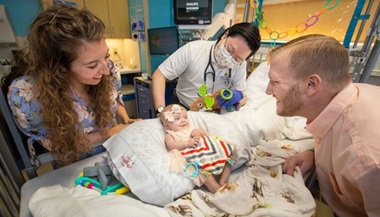Chondroectodermal Dysplasia (Ellis-van Creveld Syndrome)
What You Need to Know
- Chondroectodermal dysplasia is a hereditary condition.
- A physical exam and X-rays are used to diagnose chondroectodermal dysplasia and monitor associated symptoms, like knock-knee.
- Up to 50 percent of patients with chondroectodermal dysplasia also have heart defects.
- Surgery is usually indicated to treat orthopaedic conditions associated with chondroectodermal dysplasia, like heart defects and extra fingers.
What is chondroectodermal dysplasia?
Chondroectodermal dysplasia is a genetic, autosomal recessive condition, meaning a child receives an abnormal gene from each parent. The defect results in a problem that occurs when the cartilage converts to bone while growing.
What are the symptoms of chondroectodermal dysplasia?
- Knock-knee (genu-valgum) can be very severe, caused by the flattening of the growth plate on the outside, top portion of the shinbone (tibia)
- Short stature
- Nail and teeth abnormalities
- Extra fingers (polydactyly)
What are the risk factors of chondroectodermal dysplasia?
While chondroectodermal dysplasia is generally an uncommon condition, it has been found to be common among the Amish population.
Chondroectodermal Dysplasia Diagnosis
Diagnoses of chondroectodermal dysplasia requires a physical exam and X-rays of the lower extremities to monitor knock-knee.
Chondroectodermal Dysplasia Treatment
Children should be monitored so they can be treated with surgery to help guide their growth due to misalignment and malrotation of the lower extremities.
Surgical procedures are required to remove extra fingers, correct heart defects and to correct knock-knee. For knock-knee, osteotomies can be done to the growth plates to correct the abnormal angel of the knees, but there is a high rate of recurrence, and additional surgeries may be necessary.





